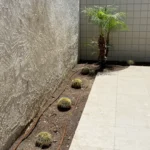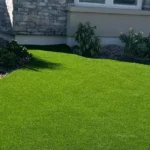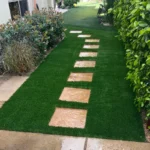Desert climate offers year-round sunshine, mild winters, and low humidity, making it an ideal place to enjoy an outdoor garden. However, the desert-like conditions can make plant care challenging due to high temperatures and limited rainfall. If you want your garden to flourish, here are essential tips for creating a thriving, sustainable landscape that’s well-suited to arid environment.
1. Choose Drought-Tolerant Plants
Native and drought-resistant plants are the backbone of any garden in a dry climate. These plants are adapted to low water conditions and thrive in the desert heat.
- Popular Choices: Succulents, cacti, agave, lavender, sage, and rosemary are excellent low-water options. They not only conserve water but also add vibrant colors and textures to your garden.
- Native Plants: California native plants, such as California poppy, manzanita, and ceanothus, are well-suited to desert climate and require less water, fertilizer, and maintenance than non-native plants.
2. Use Mulch for Moisture Retention
Mulch is a lifesaver in desert environments, helping retain moisture, regulate soil temperature, and reduce the need for frequent watering.
- Types of Mulch: Organic options like wood chips or bark are beneficial for gardens, while gravel or decorative rocks work well in succulent beds and drought-tolerant landscapes.
- Application Tips: Apply a 2–3 inch layer of mulch around plants to help reduce evaporation, protect roots from heat, and suppress weed growth. Be mindful to leave a small gap around plant stems to prevent mold.
3. Optimize Your Watering Schedule
Efficient watering is key to plant survival in arid environments. Aim to water deeply and infrequently to promote strong, resilient root systems.
- Early Morning or Evening: Watering during cooler parts of the day reduces evaporation and helps plants absorb more water.
- Drip Irrigation Systems: A drip irrigation system delivers water directly to the roots, conserving water and avoiding runoff. It’s ideal for desert climates where every drop counts.
- Check Soil Moisture: Test soil moisture by sticking your finger an inch below the surface; if it’s dry, it’s time to water. Desert plants need soil that dries out between waterings.
4. Consider Raised Beds or Mounds for Better Drainage
In desert environments, drainage is just as important as water conservation. Raised beds or mounds allow you to control soil composition and improve water drainage, reducing the risk of root rot.
- Drainage Benefits: Raised beds help excess water drain more effectively, ensuring that roots aren’t sitting in moisture for too long, which can lead to disease.
- Soil Mixtures: Use a well-draining soil mix with sand, pumice, or perlite in raised beds to prevent waterlogging. Succulents and cacti especially benefit from loose, sandy soils.
5. Use Shade Cloth or Temporary Shade for New Plants
Summer sun can be intense, especially for young plants that are still establishing their root systems. A little extra shade can make a big difference in their early days.
- Shade Cloth: Install shade cloths over tender plants during the hottest parts of the summer to protect them from extreme heat.
- Temporary Shade Options: You can use garden umbrellas, shade sails, or even plant taller, established plants nearby to create natural shade.
6. Fertilize Sparingly and Choose Low-Nitrogen Options
In desert gardens, fertilizing should be done sparingly. Desert plants have adapted to nutrient-poor soils, so over-fertilizing can lead to rapid, weak growth that may not survive our arid conditions.
- Low-Nitrogen Fertilizers: Desert plants typically require fertilizers low in nitrogen, which encourages slower, more stable growth. Look for slow-release options to nourish plants gradually.
- Timing: Fertilize in early spring when plants are beginning to grow. Avoid fertilizing in the heat of summer, as it can put extra stress on plants during their most water-conserving season.
7. Prune Strategically to Improve Airflow
Pruning helps maintain plant health and promotes airflow around plants, reducing the risk of fungal growth in the desert’s warm climate.
- Prune in Cooler Months: It’s best to prune in early spring or late fall to avoid stressing plants in the summer heat.
- Encourage Airflow: Remove dead or excess branches to improve airflow, which can help prevent moisture buildup and reduce the risk of disease.
8. Monitor for Pests Regularly
Desert climates aren’t free from pests; in fact, pests like aphids, mealybugs, and spider mites can thrive in warm temperatures. Regularly inspect your plants and take action early if you spot any issues.
- Organic Pest Control: Use organic insecticidal soaps or neem oil as safe, eco-friendly solutions for controlling pests without harming beneficial insects.
- Beneficial Insects: Ladybugs, lacewings, and praying mantises are natural predators of common pests. You can purchase these beneficial insects or encourage them by planting a variety of flowering plants.
9. Embrace Hardscaping and Decorative Elements
To conserve water and reduce plant stress, consider balancing greenery with hardscaping elements such as stones, pathways, and rock gardens. These elements add visual interest without the need for constant watering or maintenance.
- Rock Gardens: Rock gardens work beautifully with succulents and cacti, blending seamlessly into the landscape while requiring little care.
- Pathways and Seating Areas: Use gravel pathways, stone seating areas, or raised planters to create a functional, appealing space that conserves water.
Create a Thriving, Low-Water Garden in Desert Climate
With careful plant selection, water management, and some thoughtful planning, you can create a lush, thriving garden that enhances your property while conserving water. Whether you’re interested in vibrant flower beds, a succulent garden, or a balanced mix of plants and hardscapes, these tips will help you build a beautiful, sustainable outdoor oasis.
Looking for professional help to design a desert-friendly garden?








